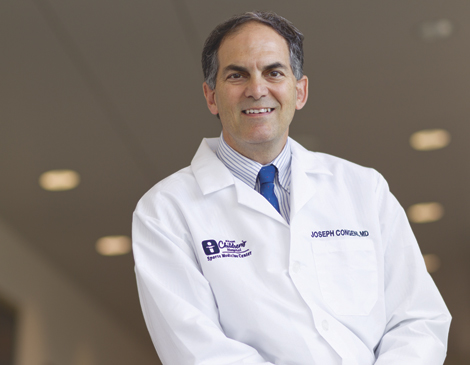Best Doctors: What's Next In Brain Health?
by James Bigley II, Arbela Capas, Lynne Thompson, Kevin Carpenter | Jul. 29, 2019 | 12:00 PM

Every year, nearly 12,000-15,000 patients in the United States are diagnosed with glioblastoma, the most common primary malignant brain tumor. Despite advances in surgery, radiation and chemotherapy, the outcomes of standard treatments are dismal.
According to Dr. Manmeet Ahluwalia, associate director and head of operations for Burkhardt Brain Tumor and Neuro-oncology Center and chair in neuro-oncology at the Cleveland Clinic, the tumors tend to grow back within 7-9 months from diagnosis. Most patients only live 15 to 16 months.
“The actual tumor spreads like spiderwebs, which involves a much greater area of the brain,” says Ahluwalia. “This is a highly aggressive tumor that can potentially double in 3 to 4 weeks.”
But SurVaxM, a novel cancer vaccine, may turn the tide by stimulating an immune response that targets survivin, a tumor-specific intercellular protein present on cancer cells. Ahluwalia was a co-lead investigator in a recent phase 2 trial involving 63 patients at five cancer centers in the U.S., including the Cleveland Clinic.
Typically, he says, only 65% of patients are alive one year after receiving standard treatment, but the vaccine trial revealed 86% of the patients were alive one year after their first vaccine and 25% did not have their tumor grow back again after two years of continued treatment.
Those findings influenced the FDA’s decision to expedite future studies in the hopes they could approve the vaccine as a widely accessible form of treatment.
“The next step is to show greater effectiveness in a randomized, clinical trial,” says Ahluwalia, “which is being planned right now.”

How Cooling The Brain Might Cure Concussions
We’re used to putting ice on our injuries, so why not use that same philosophy for concussions?
Dr. Jospeh Congeni, medical director of sports medicine at Akron Children’s Hospital, is the principal investigator on Pro-To-Cool, a pilot study that looks at how cooling the brain can help it recover from concussions faster. Using a “cool cap,” children who had symptoms of a concussion received a 30-minute treatment within the first seven days of the injury. Congeni updates us on his research.
Q. How do brain injuries and concussions affect young athletes?
A. With some of the research in the last 15 years, we can confidently say now that concussions are different in younger athletes. Those kinds of concussions are different. Kids take twice as long for the brain to recover from a concussion.
Q. What makes you think cooling the brain could work?
A. For years, from being on the sidelines in high school and college, I’ve seen how we ice and treat knees, ankles and shoulders. Fifty percent of injuries we see get better with icing. I’ve thought about icing the brain for a while but we always thought the brain is encased in this bone around it, the skull. Could we really get much icing to the brain? Would it be beneficial?
Q. How does this treatment work?
A. Cooling the body decreases the metabolic rate, decreases inflammation and so in a lot of neonatal studies of brain trauma and brain injury, they cooled the brain and they had really good effects. So it isn’t something that’s new, we just didn’t know how to apply it. We got together with a group of engineers and they helped design this cap so that we could maximize the cooling effect around the head and try and get some cooling to the brain. There are flaps that go across the carotid arteries that bring blood into the brain.

Could An Asthma And Stroke Treatment Slow Down The Effects Of MS?
One of the most widely accepted measures of progressive multiple sclerosis, a disease characterized by a gradual worsening of neurologic function, is brain shrinkage.
“Shrinkage probably means there’s injury, probably means there’s irreversible damage,” says Dr. Robert Fox, vice chair for research in the Cleveland Clinic’s Neurological Institute.
But Ibudilast, an oral drug originally approved 30 years ago in Japan to treat asthma and post-stroke symptoms, might provide hope for those suffering from the disease, for which there are very limited treatments.
A two-year phase 2 trial led by the Clinic and Fox showed that Ibudilast slowed the progression of whole brain atrophy, or brain shrinkage, by 48% versus activity in patients taking a placebo.
“If you have a drug that can slow the shrinkage, that’s probably a good thing,” Fox says. A phase 3 trial must be conducted to determine whether slowing brain shrinkage delays worsening of symptoms such as difficulty walking and thinking.
But the phase 2 trial already has provided researchers with a valuable tool to identify a better biomarker, a measurable indicator in the body of a disease’s severity.
“What we need is to develop new biomarkers that can be used in another phase 2 trial to test out the proof of concept,” Fox says, “to help us test more drugs more quickly, to then point to which ones we should try in a larger phase 3 trial.”

How Ultrasounds Can Be Used As A Diagnostics Tool
Peripheral neuropathy, or damage to nerves that carry messages from the brain to the body, can result in pain, numbness or paralysis. Over the last decade though, neuromuscular ultrasound has re-emerged as a top diagnostic tool for these problems. We caught up with Dr. David Preston, vice chair of University Hospitals’ department of neurology, to learn more about ultrasound’s bright future.
Q. Why is ultrasound having this resurgence?
A. The quality of the technology, particularly the resolution, has markedly improved. Ultrasound is quick, totally painless and presents no side effects. Ultrasound is very high quality at a relatively low cost. Machines used to cost several hundred thousand dollars, but can now be purchased for around $30,000 to $40,000.
Q. How does ultrasound impact brain health?
A. Even though ultrasound doesn’t test brain function, it allows us to assess the peripheral nerves and muscles by diagnosing the problem. Those are the effectors of any decision by the brain, like walking across the room. They make it happen.
Q. What can neuromuscular ultrasound detect?
A. For patients with idiopathic peripheral neuropathy, meaning we don’t know the cause, an ultrasound can find the source of the problem. There might be evidence of large nerves, which could mean inflammatory autoimmune neuropathy, or something else entirely. Ten years ago, we wouldn’t have been able to figure this stuff out.
Click here to read explanations of the 15 most common diseases that affect the brain.
Click here to read the more articles from Best Doctors: Special Brain Health Report cover package.
Trending
-
1
-
2
-
3
-
4
-
5










